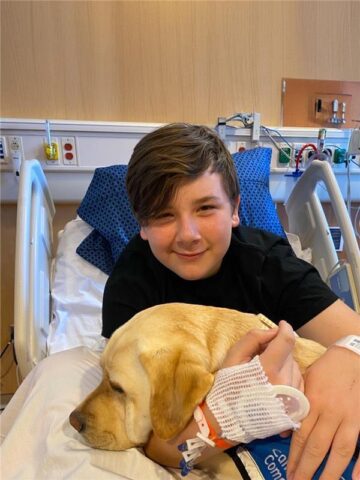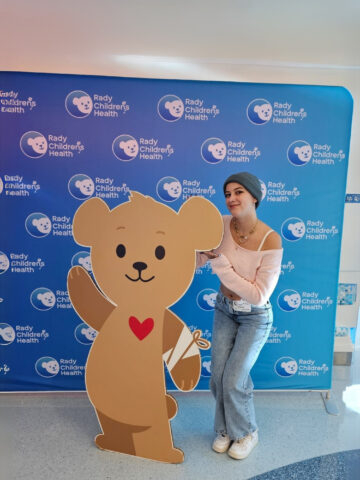A child, resting in bed, fires up her 7-inch tablet and opens an app.
She selects from a variety of cartoon avatars — such as a panda or penguin — and backgrounds that include a colorful ocean floor with fish and other sea creatures.
Game on.
But this isn’t a typical game. It’s a kid-friendly tool that allows the child, who is being treated for cancer, to report the severity and type of pain she’s experiencing from her home — information her doctor can access in real time.
The app, named Pain Buddy, may aid in the reduction of pain severity in children during cancer treatment, according to results of a pilot study recently published in the online journal Pediatric Blood & Cancer.
The study found that Pain Buddy may be especially beneficial in helping children who have high levels of pain.
Pain Buddy is the brainchild of Michelle A. Fortier, a CHOC pediatric psychologist who is also a faculty member of the UC Irvine Sue & Bill Gross School of Nursing.
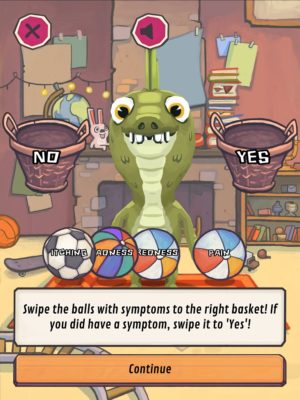
Fortier, who specializes in pain management in children, was principal investigator of the recently published pilot study that was based on clinical studies of CHOC patients monitored by pediatric oncologist Dr. Lilibeth Torno and pediatric oncology nurse practitioner Christine Yun.
“Pain management is an important part of cancer survivorship, and I think Pain Buddy’s potential for use is very broad,” Dr. Torno says.
Most of the 48 children participating in the eight-week study had been diagnosed with childhood leukemia. All were between the ages of 8 and 18. Results of this particular study come amid ongoing studies on the Pain Buddy app at other sites. Results of the comprehensive research effort, which will track 206 children, are expected in three years, Fortier says.
Pain Buddy, Fortier explains, was developed a few years ago to address a gap in pain management of kids at home compared to kids in the hospital, where it’s easier for doctors and nurses to stay on top of patients’ needs. The 48 children who participated in the pilot study spent a lot of time at home.
Tapping the expertise of professional app developers and researchers at UCI in the California Institute for Telecommunication and Information Technology (Calit2), Fortier and several other colleagues came up with a way for children to rate their pain as they were feeling it from home.
“Most kids experience pretty moderate to severe pain throughout their cancer treatment, and this pain just wasn’t sufficiently being addressed when the patients were at home,” Fortier says. “And when we think about pain assessment, we’re really terrible retrospective reporters of our pain experience.”
But with Pain Buddy, users can say how much they’re hurting, and where, as it’s happening.
“Pain can come from the cancer itself, such as a solid tumor, and it can come from treatment procedures,” Fortier says. “For example, lots of skin-breaking procedures occur during cancer treatment. And treatments like chemotherapy can cause nerve pain, inflammation of the gastrointestinal tract and mouth sores.”
In addition to completing a pain and symptom diary twice daily, the app automatically alerted the participants’ medical teams about such symptoms as nausea, itching, sadness and redness.
With a touch of a finger, the patients could select word bubbles to indicate descriptions — such as bad, annoying or terrible — to describe their pain.
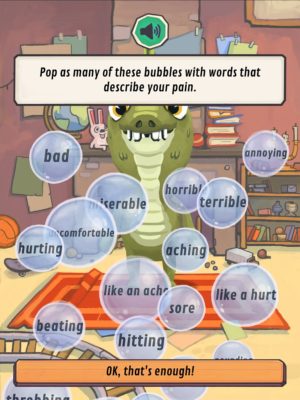
Clinicians, in turn, could promptly address any symptoms that warranted intervention.
A key component of the Pain Buddy app, which for now only has been used by the pilot study participants, is the incorporation of coping skills shown to be effective in the management of pain, such as deep breathing, progressive muscle relaxation and guided imagery for kids.
During these skills training exercises, patients could accumulate coins and, visiting a virtual store, customize their personal avatar and buy additional background themes.
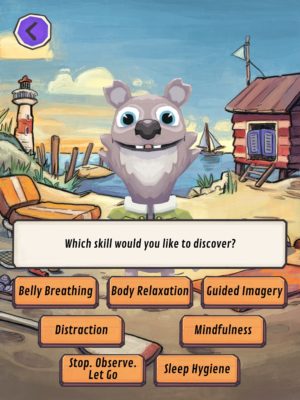
Pain Buddy represents an effective partnership between parents, young cancer patients and the health care institutions that treat them, Dr. Torno says.
“Our focus on cancer survivorship begins on the day of diagnosis,” Torno says.
CHOC’s After Cancer Treatment Survivorship (ACTS) program features a multidisciplinary team of clinical experts who monitor the late effects of cancer and develop a plan for long-term surveillance to ensure the best possible outcomes. Every child at CHOC who has gone through cancer therapy eventually lands in the ACTS program.
Fortier said the ultimate goal is to further refine Pain Buddy and license the app to hospitals for widespread use.
“The goal is to have every kid undergoing cancer treatment — from sarcoma patients to those with bone and other cancers — to have the ability to use Pain Buddy.”
Get more expert health advice delivered to your inbox monthly by subscribing to the KidsHealth newsletter here.

Learn more the Hyundai Cancer Center at CHOC
CHOC Hospital was named one of the nation’s best children’s hospitals by U.S. News & World Report in its 2025-26 Best Children’s Hospitals rankings and ranked in the oncology specialty.

